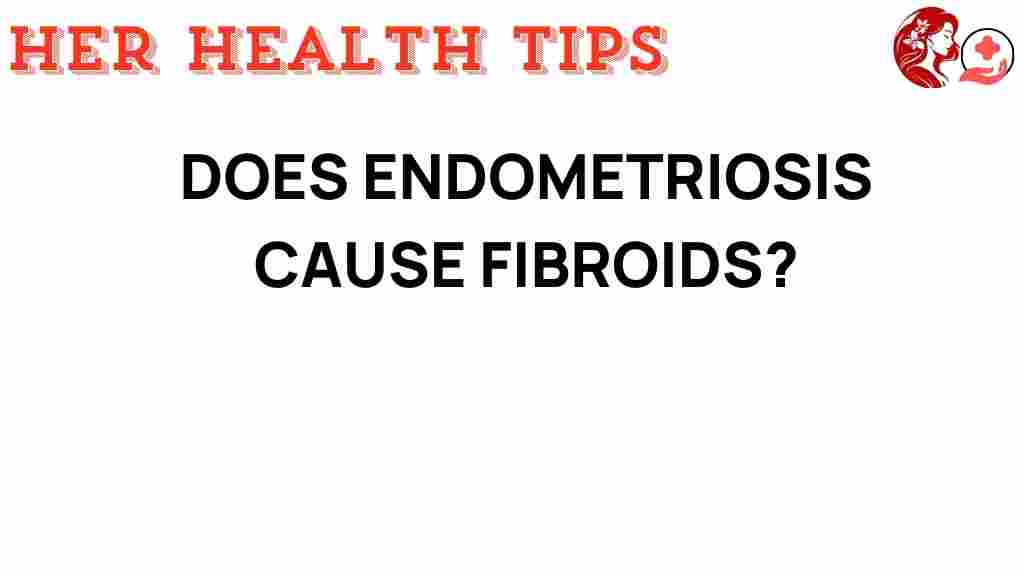Unraveling the Connection: Does Endometriosis Cause Fibroids?
When it comes to women’s health, understanding the complex interplay between various reproductive health conditions is crucial. Two of the most common conditions affecting women are endometriosis and fibroids. Both can significantly impact a woman’s quality of life, yet many women are left wondering about the connection between these two conditions. This article aims to explore whether endometriosis can lead to the development of fibroids, the symptoms associated with both conditions, their diagnosis, and treatment options available.
Understanding Endometriosis
Endometriosis is a painful condition in which tissue similar to the lining of the uterus grows outside the uterus. This misplaced tissue can cause inflammation, scar tissue, and adhesions, leading to various symptoms, including:
- Severe menstrual cramps
- Pain during intercourse
- Pain with bowel movements or urination
- Excessive bleeding during periods
- Infertility
Endometriosis can affect women of reproductive age, and the severity of the symptoms is not always an indicator of the extent of the condition. Diagnosis typically involves pelvic exams, ultrasounds, and sometimes laparoscopy.
Understanding Fibroids
Fibroids, or uterine leiomyomas, are noncancerous growths of the uterus that often appear during childbearing years. They can vary in size and number and may lead to symptoms such as:
- Heavy menstrual bleeding
- Pelvic pressure or pain
- Frequent urination
- Constipation
- Backache
Like endometriosis, fibroids can also affect reproductive health and fertility. The diagnosis of fibroids usually involves pelvic ultrasounds and MRIs.
Exploring the Connection Between Endometriosis and Fibroids
Many women with endometriosis may also develop fibroids, leading to speculation about a possible connection between the two conditions. Although research on this topic is ongoing, some studies suggest the following:
1. Hormonal Imbalance
Both endometriosis and fibroids are influenced by hormonal factors, particularly estrogen. Hormonal imbalance may contribute to the development of both conditions. Elevated levels of estrogen can stimulate the growth of both endometrial tissue and fibroids, suggesting a shared pathway in their development.
2. Inflammation
Endometriosis is characterized by chronic inflammation, which may also play a role in fibroid development. Inflammatory cytokines and growth factors may promote the growth of fibroids in women with endometriosis.
3. Genetic Factors
Some studies indicate that women with a family history of endometriosis or fibroids may be at a higher risk for developing both conditions. This suggests potential genetic factors that predispose women to these reproductive health issues.
Symptoms: How to Identify Endometriosis and Fibroids
Recognizing the symptoms of endometriosis and fibroids is crucial for timely diagnosis and treatment. While there is some overlap, the symptoms can differ significantly:
Common Symptoms of Endometriosis:
- Chronic pelvic pain
- Painful periods (dysmenorrhea)
- Pain during intercourse
- Fatigue
- Infertility
Common Symptoms of Fibroids:
- Heavy menstrual bleeding
- Pelvic pressure and discomfort
- Frequent urination
- Enlarged uterus
- Back pain
It is essential for women experiencing these symptoms to consult a healthcare provider for proper evaluation and diagnosis.
Diagnosis of Endometriosis and Fibroids
Diagnosing these conditions often requires a combination of medical history, physical examinations, and imaging tests. Here’s a step-by-step process for diagnosis:
1. Medical History and Symptom Review
The healthcare provider will begin by taking a thorough medical history and discussing symptoms. This information is critical for understanding the patient’s condition.
2. Physical Examination
A pelvic examination may be conducted to check for abnormalities or signs of endometriosis or fibroids.
3. Imaging Tests
- Ultrasound: Often the first imaging test used to detect fibroids.
- MRI: More detailed imaging that can identify the size and location of fibroids and assess the extent of endometriosis.
4. Laparoscopy
If endometriosis is suspected, a laparoscopy may be performed. This surgical procedure allows for direct visualization of the pelvic organs and the possibility of biopsy.
Treatment Options for Endometriosis and Fibroids
Understanding the treatment options for endometriosis and fibroids is vital for managing symptoms and improving reproductive health. Treatment plans are often personalized based on the severity of symptoms, the extent of the conditions, and the woman’s reproductive goals.
1. Treatment for Endometriosis
- Medications: Pain relief medications, hormonal therapies (such as birth control pills, GnRH agonists) to reduce or eliminate menstruation.
- Surgery: For severe cases, laparoscopic surgery may be necessary to remove endometrial tissue and adhesions.
- Fertility Treatment: In cases of infertility, assisted reproductive technologies like IVF may be recommended.
2. Treatment for Fibroids
- Medications: Hormonal treatments can help manage symptoms but may not eliminate fibroids.
- Minimally Invasive Procedures: Uterine artery embolization or MRI-guided focused ultrasound can shrink fibroids.
- Surgery: Myomectomy (removal of fibroids) or hysterectomy (removal of the uterus) may be options, especially for larger fibroids or significant symptoms.
Troubleshooting Tips: Managing Symptoms
For women dealing with the symptoms of endometriosis or fibroids, here are some management tips:
- Diet: Maintaining a balanced diet rich in fruits, vegetables, and whole grains can help combat inflammation.
- Exercise: Regular physical activity can alleviate some symptoms and improve overall health.
- Pain Management: Consider over-the-counter pain relievers and alternative therapies like acupuncture.
- Support Groups: Joining support groups can provide emotional support and shared experiences.
For more information on managing these conditions, you can visit Women’s Health Foundation.
Conclusion
In summary, while there is no definitive evidence that endometriosis directly causes fibroids, the two conditions share common pathways, including hormonal imbalances and inflammation. Women experiencing symptoms of either condition should seek medical advice for proper diagnosis and tailored treatment options. By understanding their bodies and seeking support, women can navigate these challenges and improve their reproductive health.
For further insights into women’s health issues, feel free to explore our other articles on reproductive health.
This article is in the category Reproductive and created by HerHealthTips Team
